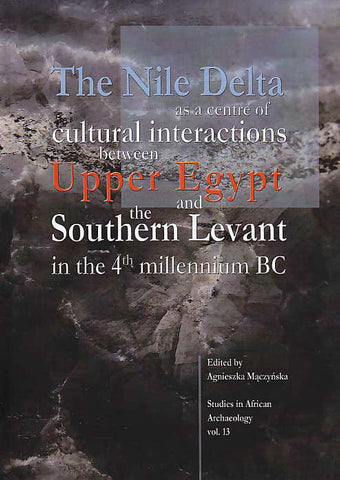The Nile Delta as a centre of cultural interactions between Upper Egypt and the Southern Levant in 4th millennium BC
65,00 $
ISBN: 978-83-60109-35-9
Description: softcover, 318 pages (17x24 cm), drawings, plans, photographs
Condition: very good
Weight: 685g.
The Nile Delta as a centre of cultural interactions between Upper Egypt and the Southern Levant in 4th millennium BC, edited by A. Mączyńska, Studies in African Archaeology, vol. 13, Poznan Archaeological Museum 2014
This volume is part of and concludes the project entitled The Nile Delta as a centre of cultural interactions between Upper Egypt and the Southern Levant in 4th millennium BC. It contains a collection of papers by researchers involved in investigating the development of the Nile Delta in the Pre- and Protodynastic Periods. Nearly all of these papers were presented at the same-titled conference held on June 21 and 22, 2013 in the Archeological Museum in Poznań, Poland. Although originally planned as a workshop presenting the results of research carried out as part of the project, the conference eventually evolved into a major event and became an opportunity to meet and talk about the role of Delta communities in the development of the Egyptian civilization in the 4th millennium BC, with particular emphasis on their relations with neighboring areas, i.e. the Southern Levant and Upper Egypt. The conference was attended both by project partners and by invited guests whose papers made an excellent addition to the main topic of the event. Only the paper by Steven Rosen was presented at a workshop called Imports during the Naqada Period: Investigating Two Sides of a Phenomenon organized by W. F. Albright Institute of Archaeological Research in Jerusalem on November 26, 2012. The main goal of the workshop was to meet Israeli archeologists, who keep finding Egyptian imports on various sites. An important element of the workshop was the opportunity to discuss Egyptian-Levantine relationships not only from the Egyptian, but also from the Levantine perspective. The article by Steven Rosen is a fine example here.
Agnieszka Maczynska
Preface
Partners of the project
Participants of the conference
List of authors
Edwin C.M. van den Brink
Introduction
Bartosz Adamski & Karolina Rosinska-Balik
Brewing technology in Early Egypt. Invention of Upper or Lower Egyptians?
Eliot Braun
Reflections on the context of a late Dynasty 0 Egyptian colony in the Southern Levant: Interpreting some evidence of Nilotic material culture at select sites in the Southern Levant (ca. 3150 BCE – ca. 2950 BCE)
Marek Chlodnicki
Tell el-Farkha. The changes in spatial organisation of the settlement – from the
Predynastic to the Early Dynastic periods
Wouter Claes, Stan Hendrickx, Anne Devillers, Elizabeth Hart, Karin Kindermann, Morgan de Dapper, Salima Ikram, Geertrui Storms, Carla Swerts & Dirk Huyge
From the early Old Kingdom to the Badarian. Preliminary report on the 2012 excavation campaign in the settlement area of Elkab
Marcin Czarnowicz
Erani C pottery in Egypt
Joanna Debowska-Ludwin
The picture of Naqadan-Lower Egyptian transition reconstructed on the basis of sepulchral data
Amir Golani
Ashqelon during the EB I period – a centre for copper processing and trade
Jacek Karmowski
Settlement architecture on the Eastern Kom at Tell el-Farkha. A 3D reconstruction
E. Christina Kohler
Of Pots and Myths - attempting a comparative study of funerary pottery assemblages in the Egyptian Nile Valley during the late 4th millennium BC
Agnieszka Maczynska
Some remarks on the visitors in the Nile Delta in the 4th millennium BC
Mary F. Ownby
Petrographic analysis of pottery from Tell el-Farkha
Thilo Rehren & Ernst Pernicka
First data on the nature and origin of the metalwork from Tell el-Farkha
Steven Rosen
Lithic systems of the 4th millennium BC: a brief comparison between the industries of Egypt and the Southern Levant
Joanne M. Rowland
Interregional exchange: the evidence from Kafr Hassan Dawood, East Delta
Penelope Wilson
The Prehistoric sequence at Sais: temporal and regional connections












